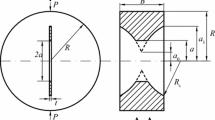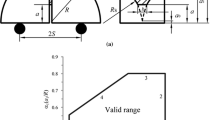Abstract
The International Society of Rock Mechanics (ISRM) suggested cracked chevron notched Brazilian disc method falls into a major testing category of rock fracture toughness measurement by virtue of chevron notched rock samples. A straight through crack front during the whole fracturing process is assumed in the testing principle but is never assessed. In this study, the progressive rock fracture mechanism of cracked chevron notched Brazilian disc rock specimens is numerically simulated for the first time. Two representative sample types with distinct geometry of notch ligaments are modelled. The assumption of a straight through crack front for chevron notched fracture samples is critically assessed. The results show that not only the notch tip but also the saw-cut chevron notch cracks during the experiments. The straight through crack front assumption is never satisfied in the realistic rock fracture progress of chevron notched disc samples. In addition, the crack features prominent curved front, far from being straight. In contrast to the sample type with narrow notch ligament, the acoustic emission (AE) of the simulation on the sample with wide notch ligament depicts obvious biased fracturing of the prescript fracturing route of the notch. The numerically observed progressive fracture mechanism calls for more attention on how to accurately calibrate the critical dimensionless stress intensity factor for a better measurement of Mode I fracture toughness via chevron notched samples.





















Similar content being viewed by others
References
Aliha MRM, Ayatollahi MR (2014) Rock fracture toughness study using cracked chevron notched Brazilian disc specimen under pure modes I and II loading—a statistical approach. Theor Appl Fract Mech 69:17–25. doi:10.1016/j.tafmec.2013.11.008
Aliha MRM, Ayatollahi MR, Smith DJ, Pavier MJ (2010) Geometry and size effects on fracture trajectory in a limestone rock under mixed mode loading. Eng Fract Mech 77(11):2200–2212
Aliha MRM, Ayatollahi MR, Akbardoost J (2012a) Typical upper bound–lower bound mixed mode fracture resistance envelopes for rock material. Rock Mech Rock Eng 45(1):65–74
Aliha MRM, Sistaninia M, Smith DJ, Pavier MJ, Ayatollahi MR (2012b) Geometry effects and statistical analysis of mode I fracture in guiting limestone. Int J Rock Mech Min Sci 51:128–135
Aliha MRM, Hosseinpour GR, Ayatollahi MR (2013) Application of cracked triangular specimen subjected to three-point bending for investigating fracture behavior of rock materials. Rock Mech Rock Eng 46(5):1023–1034
Al-Shayea NA, Khan K, Abduljauwad SN (2000) Effects of confining pressure and temperature on mixed-mode (I–II) fracture toughness of a limestone rock. Int J Rock Mech Min Sci 37:629–643
Amrollahi H, Baghbanan A, Hashemolhosseini H (2011) Measuring fracture toughness of crystalline marbles under modes I and II and mixed mode I–II loading conditions using CCNBD and HCCD specimens. Int J Rock Mech Min Sci 48(7):1123–1134
Anderson TL (2005) Fracture mechanics: fundamentals and applications. CRC Taylor & Francis, New York
Atkinson C, Smelser RE, Sanchez J (1982) Combined mode fracture via the cracked Brazilian disk test. Int J Fract 18(4):279–291
Awaji H, Sato S (1978) Combined mode fracture toughness measurement by the disk test. J Eng Mater Technol 100(2):175–182
Chang S-H, Lee C-I, Jeon S (2002) Measurement of rock fracture toughness under modes I and II and mixed-mode conditions by using disc-type specimens. Eng Geol 66:79–97
Chen C-S, Pan E, Amadei B (1998) Fracture mechanics analysis of cracked discs of anisotropic rock using the boundary element method. Int J Rock Mech Min Sci 35(2):195–218
Chen C-H, Chen C-S, Wu J-H (2008) Fracture toughness analysis on cracked ring disks of anisotropic rock. Rock Mech Rock Eng 41(4):539–562
Chong KP, Kuruppu MD (1984) New specimen for fracture toughness determination for rock and other materials. Int J Fract 26:R59–R62
Cui Z-D, Liu D-A, An G-M, Sun B, Zhou M, Cao F-Q (2010) A comparison of two ISRM suggested chevron notched specimens for testing mode-I rock fracture toughness. Int J Rock Mech Min Sci 47:871–876
Dai F, Xia K (2013) Laboratory measurements of the rate dependence of the fracture toughness anisotropy of Barre granite. Int J Rock Mech Min Sci 60:57–65
Dai F, Chen R, Xia K (2010a) A semi-circular bend technique for determining dynamic fracture toughness. Exp Mech 50(6):783–791
Dai F, Chen R, Iqbal MJ, Xia K (2010b) Dynamic cracked chevron notched Brazilian disc method for measuring rock fracture parameters. Int J Rock Mech Min Sci 47(4):606–613
Dai F, Xia K, Zheng H, Wang YX (2011) Determination of dynamic rock mode-I fracture parameters using cracked chevron notched semi-circular bend specimen. Eng Fract Mech 78(15):2633–2644
Dwivedi RD, Soni AK, Goel RK, Dube AK (2000) Fracture toughness of rocks under sub-zero temperature conditions. Int J Rock Mech Min Sci 37:1267–1275
Erarslan N, Williams DJ (2012) The damage mechanism of rock fatigue and its relationship to the fracture toughness of rocks. Int J Rock Mech Min Sci 56:15–26
Erarslan N, Liang ZZ, Williams DJ (2012) Experimental and numerical studies on determination of indirect tensile strength of rocks. Rock Mech Rock Eng 45(5):739–751
Fowell RJ (1995) ISRM Commission on Testing Methods. Suggested method for determining mode I fracture toughness using cracked chevron notched Brazilian disc (CCNBD) specimens. Int J Rock Mech Min Sci Geomech Abstr 32(1):57–64
Fowell RJ, Xu C (1994) The use of the cracked Brazilian disc geometry for rock fracture investigations. Int J Rock Mech Min Sci Geomech Abstr 31(6):571–579
Fowell RJ, Xu C, Dowd PA (2006) An update on the fracture toughness testing methods related to the cracked chevron-notched Brazilian disk (CCNBD) specimen. Pure Appl Geophys 163(5–6):1047–1057
Ghazvinian A, Nejati HR, Sarfarazi V, Hadei MR (2013) Mixed mode crack propagation in low brittle rock-like materials. Arab J Geosci 6(11):4435–4444
Guo H, Aziz NI, Schmidt LC (1993) Rock fracture-toughness determination by the Brazilian test. Eng Geol 33(3):177–188
Iqbal MJ, Mohanty B (2007) Experimental calibration of ISRM suggested fracture toughness measurement techniques in selected brittle rocks. Rock Mech Rock Eng 40(5):453–475
Krishnan GR, Zhao XL, Zaman M, Roegiers J-C (1998) Fracture toughness of a soft sandstone. Int J Rock Mech Min Sci 35:695–710
Kuruppu MD (1997) Fracture toughness measurement using chevron notched semi-circular bend specimen. Int J Fract 86(4):L33–L38
Kuruppu MD, Obara Y, Ayatollahi MR, Chong KP, Funatsu T (2013) ISRM-suggested method for determining the mode I static fracture toughness using semi-circular bend specimen. Rock Mech Rock Eng 47(1):267–274. doi:10.1007/s00603-013-0422-7
Liang ZZ, Xing H, Wang SY, Williams DJ, Tang CA (2012) A three-dimensional numerical investigation of the fracture of rock specimens containing a pre-existing surface flaw. Comput Geotech 45:19–33
Lim IL, Johnston IW, Choi SK (1993) Stress intensity factors for semi-circular specimens under three-point bending. Eng Fract Mech 44(3):363–382
Lim IL, Johnston IW, Choi SK, Boland JN (1994) Fracture testing of a soft rock with semi-circular specimens under three-point bending. Part 1—mode I. Int J Rock Mech Min Sci Geomech Abstr 31(3):185–197
Nasseri MHB, Mohanty B (2008) Fracture toughness anisotropy in granitic rocks. Int J Rock Mech Min Sci 45(2):167–193
Ouchterlony F (1982) Review of fracture toughness testing of rock. Solid Mech Arch 7:131–211
Ouchterlony F (1984) Compliance calibration of a round fracture toughness bend specimen with chevron edge notch. Report of the Swedish Detonic Research Foundation, Stockholm
Ouchterlony F (1988) ISRM Commission on Testing Methods. Suggested methods for determining the fracture toughness of rock. Int J Rock Mech Min Sci 25:71–96
Shetty DK, Rosenfield AR, Duckworth WH (1985) Fracture toughness of ceramics measured by a chevron-notch diametral-compression test. J Am Ceram Soc 68:C325–C327
Shiryaev AM, Kotkis AM (1983) Methods for determining fracture toughness of brittle porous materials. Ind Lab 48(9):917–918
Szendi-Horvath G (1980) Fracture toughness determination of brittle materials using small to extremely small specimens. Eng Fract Mech 13:955–961
Tang CA (1997) Numerical simulation of progressive rock failure and associated seismicity. Int J Rock Mech Min Sci 34:249–261
Tang CA, Kaiser PK (1998) Numerical simulation of cumulative damage and seismic energy release during brittle rock failure—part I: fundamentals. Int J Rock Mech Min Sci 35(2):113–121
Tang CA, Liu H, Lee PKK, Tsui Y, Tham LG (2000) Numerical tests on micro-macro relationship of rock failure under uniaxial compression, part I: effect of heterogeneity. Int J Rock Mech Min Sci 37:555–569
Thiercelin M, Roegiers JC (1986) Fracture toughness determination with the modified ring test. In: Proceedings of the international symposium on engineering in complex rock formations, Beijing, China, November 1986, pp 1–8
Wang QZ, Jia XM, Kou SQ, Zhang ZX, Lindqvist P-A (2003) More accurate stress intensity factor derived by finite element analysis for the ISRM suggested rock fracture toughness specimen—CCNBD. Int J Rock Mech Min Sci 40(2):233–241
Wang QZ, Jia XM, Wu LZ (2004) Wide-range stress intensity factors for the ISRM suggested method using CCNBD specimens for rock fracture toughness tests. Int J Rock Mech Min Sci 41:709–716
Wang SY, Sloan SW, Tang CA (2013a) Three-dimensional numerical investigations of the failure mechanism of a rock disc with a central or eccentric hole. Rock Mech Rock Eng. doi:10.1007/s00603-013-0512-6
Wang QZ, Fan H, Gou XP, Zhang S (2013b) Recalibration and clarification of the formula applied to the ISRM-suggested CCNBD specimens for testing rock fracture toughness. Rock Mech Rock Eng 46(2):303–313
Wang SY, Sloan SW, Sheng DC, Yang SQ, Tang CA (2013c) Numerical study of failure behaviour of pre-cracked rock specimens under conventional triaxial compression. Int J Solids Struct 51(5):1132–1148. doi:10.1016/j.ijsolstr.2013.12.012
Weibull W (1939) A statistical theory of the strength of materials. Ing Vet Ak Handl 151:5–44
Xu NW, Tang CA, Li LC, Zhou Z, Sha C, Liang ZZ, Yang JY (2011) Microseismic monitoring and stability analysis of the left bank slope in Jinping first stage hydropower station in southwestern China. Int J Rock Mech Min Sci 48(6):950–963
Xu NW, Dai F, Liang ZZ, Zhou Z, Sha C, Tang CA (2014) The dynamic evaluation of rock slope stability considering the effects of microseismic damage. Rock Mech Rock Eng 47:621–642
Zhang S, Wang Q-Z (2009) Determination of rock fracture toughness by split test using five types of disc specimens. Rock Soil Mech 30(1):12–18 (In Chinese)
Zhou YX, Xia K, Li XB, Li HB, Ma GW, Zhao J, Zhou ZL, Dai F (2012) Suggested methods for determining the dynamic strength parameters and mode-I fracture toughness of rock materials. Int J Rock Mech Min 49:105–112
Zhu WC, Li ZH, Zhu L, Tang CA (2010) Numerical simulation on rockburst of underground opening triggered by dynamic disturbance. Tunn Undergr Space Technol 25(5):587–599
Acknowledgments
The authors are grateful for the financial support from the National Natural Science Foundation of China (Nos. 51374149 and 51209127), the Program for New Century Excellent Talents in University (NCET-13-0382) and the Doctoral Fund of Ministry of Education of China (No. 20130181110044).
Author information
Authors and Affiliations
Corresponding author
Rights and permissions
About this article
Cite this article
Dai, F., Wei, M.D., Xu, N.W. et al. Numerical Assessment of the Progressive Rock Fracture Mechanism of Cracked Chevron Notched Brazilian Disc Specimens. Rock Mech Rock Eng 48, 463–479 (2015). https://doi.org/10.1007/s00603-014-0587-8
Received:
Accepted:
Published:
Issue Date:
DOI: https://doi.org/10.1007/s00603-014-0587-8




